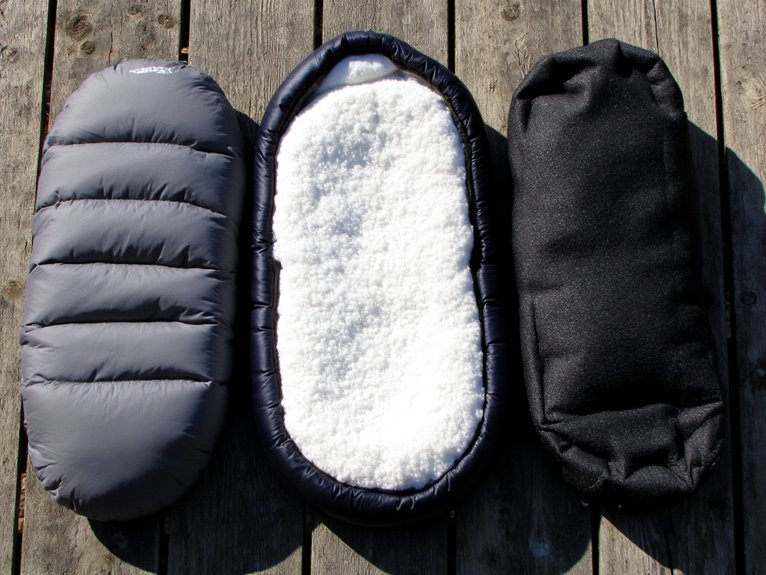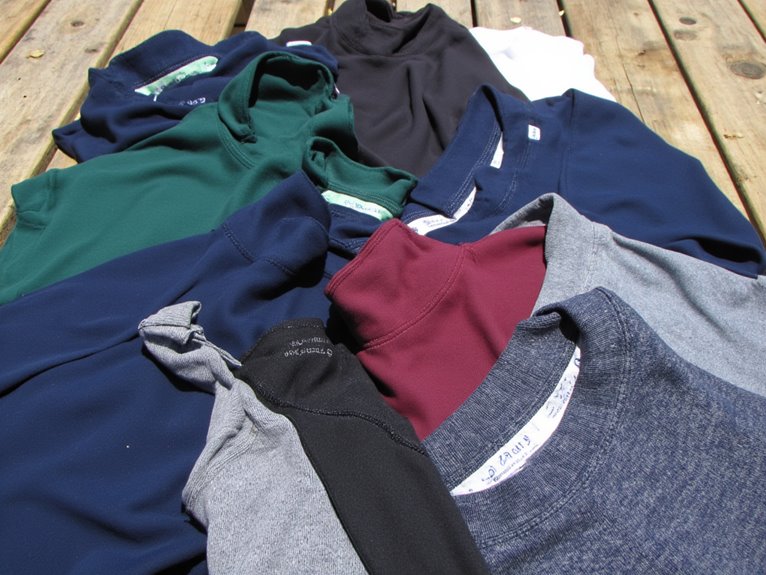What Is the Difference Between a Camping Tent and a Trekking Tent?
Camping tents and trekking tents serve distinct purposes, with camping tents prioritizing spacious, comfortable designs for relaxation and leisure, while trekking tents focus on lightweight, compact designs for efficient backpacking and mobility. Weight and portability are critical considerations, with trekking tents typically weighing between 2-4 pounds to conserve energy for the trail ahead. Capacity and interior space also vary, with camping tents offering more room to stand up and move around, while trekking tents sacrifice space for ease of transport. As you prepare for your outdoor adventure, understanding these key differences is crucial – and there's more to explore.
We are supported by our audience. When you purchase through links on our site, we may earn an affiliate commission, at no extra cost for you. Learn more. Last update on 7th January 2026 / Images from Amazon Product Advertising API.
Purpose and Design Differences
While camping tents are designed to provide spacious, comfortable accommodations for relaxation and leisure, trekking tents prioritize lightweight, compact designs that facilitate efficient backpacking and mobility.
This fundamental difference in purpose drives distinct design approaches.
Camping tents often feature larger floor plans, higher ceilings, and more windows, creating a comfortable home-away-from-home atmosphere.
In contrast, trekking tents are optimized for minimalism, with narrower profiles, fewer poles, and reduced fabric to minimize weight and bulk.
This streamlined design enables trekkers to cover greater distances with ease, making them ideal for multi-day backpacking trips.
Weight and Portability Factors
In terms of weight and portability factors, camping and trekking tents differ markedly.
The pack weight of a tent can greatly impact the overall hiking experience, making it essential to weigh the trade-off between shelter and mobility.
Pack Weight Matters
A backpacker's pack weight is a critical factor in determining the overall comfort and success of their trek, as every extra ounce can feel like a pound when carrying a heavy load over long distances.
When choosing between a camping tent and a trekking tent, it's essential to weigh the pros and cons of each option.
Trekking tents are designed to be lightweight and compact, making them ideal for multi-day backpacking trips. They typically weigh between 2-4 pounds, allowing backpackers to conserve energy for the trail ahead.
In contrast, camping tents are often heavier and bulkier, making them better suited for car-camping trips or short hikes.
Tent Fabric Choices
Beyond pack weight, the fabric choices of a tent play a significant role in determining its overall weight and portability.
For trekking tents, lightweight and water-resistant fabrics like silnylon, nylon, or polyester are preferred. These materials provide excellent durability, water resistance, and UV protection while minimizing weight.
In contrast, camping tents often employ heavier, more durable fabrics like canvas or heavy-duty polyester, which prioritize comfort and interior space over portability.
When selecting a tent, consider the trade-off between weight, durability, and protection from the elements. By choosing the right fabric, you can achieve the perfect balance between comfort and convenience on your next adventure.
Compression Options
Most backpackers and campers agree that compressing a tent to its smallest possible size is essential for efficient packing, and various compression options are available to achieve this goal.
Compression sacks, for instance, allow users to compress the tent into a compact cylinder, reducing its volume and making it easier to carry.
Trekking tents often come with built-in compression systems, such as roll-top closures or compression straps, which help to minimize their packed size.
Additionally, some tents feature innovative compression technologies, like inflatable compression bags or removable compression panels, to further reduce their bulk.
Capacity and Interior Space
When choosing between a camping tent and a trekking tent, capacity and interior space are critical considerations.
Camping tents typically offer more spacious interiors, with room for gear, luggage, and lounging around. They often feature larger floor areas, higher ceilings, and more vertical walls, providing ample space to stand up, change, and move around.
In contrast, trekking tents prioritize lightweight design and compactness, sacrificing some interior space for ease of transport.
Understand your needs and preferences to select the right tent for your adventure.
Materials and Durability
When it comes to materials and durability, both camping and trekking tents are put to the test in harsh outdoor environments.
The quality of the materials used can make all the difference in withstanding the elements, and a closer examination of water resistance ratings, fabric weights, and pole strength is crucial in determining which type of tent is best suited for your adventure.
Water Resistance Ratings
Water resistance ratings play a critical role in determining the durability and performance of a tent, particularly in harsh outdoor environments where precipitation and moisture are unavoidable.
When choosing between a camping tent and a trekking tent, understanding water resistance ratings is essential.
The most common rating system is the Hydrostatic Head (HH) measurement, which indicates a tent's ability to withstand water pressure.
A higher HH rating indicates greater water resistance. For example, a tent with a 1,500mm HH rating can withstand light rain, while a 5,000mm HH rating can handle heavy downpours.
Look for tents with a minimum HH rating of 1,000mm for camping and 2,000mm for trekking to guarantee a dry and comfortable outdoor experience.
Fabric Weights Compared
Beyond the water resistance ratings, the fabric weights and materials used in camping and trekking tents substantially impact their overall durability and performance in various outdoor conditions.
The fabric weight of a tent is measured in denier (D), which represents the thickness of the threads used.
Camping tents typically use heavier fabrics (70D-150D) for added durability and weather resistance, making them suitable for car-accessible campsites.
Trekking tents, on the other hand, employ lighter fabrics (10D-30D) to minimize weight and maximize packability, ideal for backpackers and thru-hikers.
Heavier fabrics provide better abrasion resistance and UV protection, while lighter fabrics prioritize portability over durability.
The choice of fabric weight ultimately depends on the user's priorities: comfort and protection or lightweight convenience.
When selecting a tent, consider the trade-offs between fabric weight, durability, and portability to ensure the best fit for your outdoor adventure.
Pole Strength Tested
The structural integrity of a tent relies heavily on the strength and durability of its poles, which are typically crafted from either fiberglass, aluminum, or a combination of both materials.
To guarantee peak performance, manufacturers subject these poles to rigorous testing, mimicking real-world conditions.
In a controlled environment, poles are subjected to various loads, simulating strong winds, snow, and other environmental stressors.
This testing helps to identify weaknesses, allowing manufacturers to refine their designs and materials.
The results are poles that can withstand harsh conditions, providing campers with a safe and reliable shelter.
For trekking tents, pole strength is particularly vital, as they must endure the added weight of snow and wind.
Setup and Takedown Ease
When venturing into the great outdoors, ease of setup and takedown is a critical consideration, as it can substantially impact the overall camping or trekking experience. A tent that is easy to set up and take down can make all the difference between a relaxing trip and a frustrating one.
Some key considerations when evaluating setup and takedown ease include:
- Color-coded clips and poles for intuitive assembly
- Snap-lock or pinch-free connectors for hassle-free connections
- Pre-attached guy lines and tensioners for quick deployment
- Freestanding designs that eliminate the need for stakes
- Compact, carry-friendly packs for easy transport
Weather Resistance and Waterproofing
Six critical factors contribute to a tent's weather resistance and waterproofing: fabric type, waterproof coatings, seam sealing, floor and wall design, pole strength, and guy line system.
Each of these components plays a crucial role in maintaining the tent's dryness and security in harsh weather conditions.
The type of fabric used, for instance, can greatly impact the tent's water resistance.
Waterproof coatings, such as silicone or polyurethane, are also essential in preventing water penetration.
Additionally, seam sealing and floor and wall design can make or break a tent's weather resistance.
Furthermore, pole strength and the guy line system work in tandem to maintain the tent's structure and stability in strong winds and heavy rain.
Packed Size and Storage
As outdoor enthusiasts prepare for their next adventure, a tent's packed size and storage capabilities become a critical consideration, directly impacting the ease of transportation and overall convenience of the camping or trekking experience.
A smaller packed size translates to easier carrying, while ample storage space ensures that gear remains organized and within reach.
Key considerations for packed size and storage include:
Compressed volume: Look for tents with a compact packed size to minimize bulk in your backpack.
Storage pockets: Multiple pockets and compartments help keep gear organized and accessible.
Compression sacks: Included compression sacks can further reduce the tent's packed size.
Carry weight: Lighter tents with sturdy carrying handles make transportation a breeze.
External attachments: External pockets and attachment points allow for additional storage and customization.
Budget and Price Considerations
Determining a budget and weighing price considerations is a vital step in selecting the ideal tent for your camping or trekking adventure, as it directly influences the quality and features of the tent that can be afforded.
Camping tents tend to be more affordable, with prices ranging from $50 to $200, depending on the size and features.
Trekking tents, on the other hand, are often more expensive, with prices starting at around $200 and reaching up to $500 or more for high-end models.
When setting a budget, consider factors such as the number of users, seasonality, and the level of durability required.


